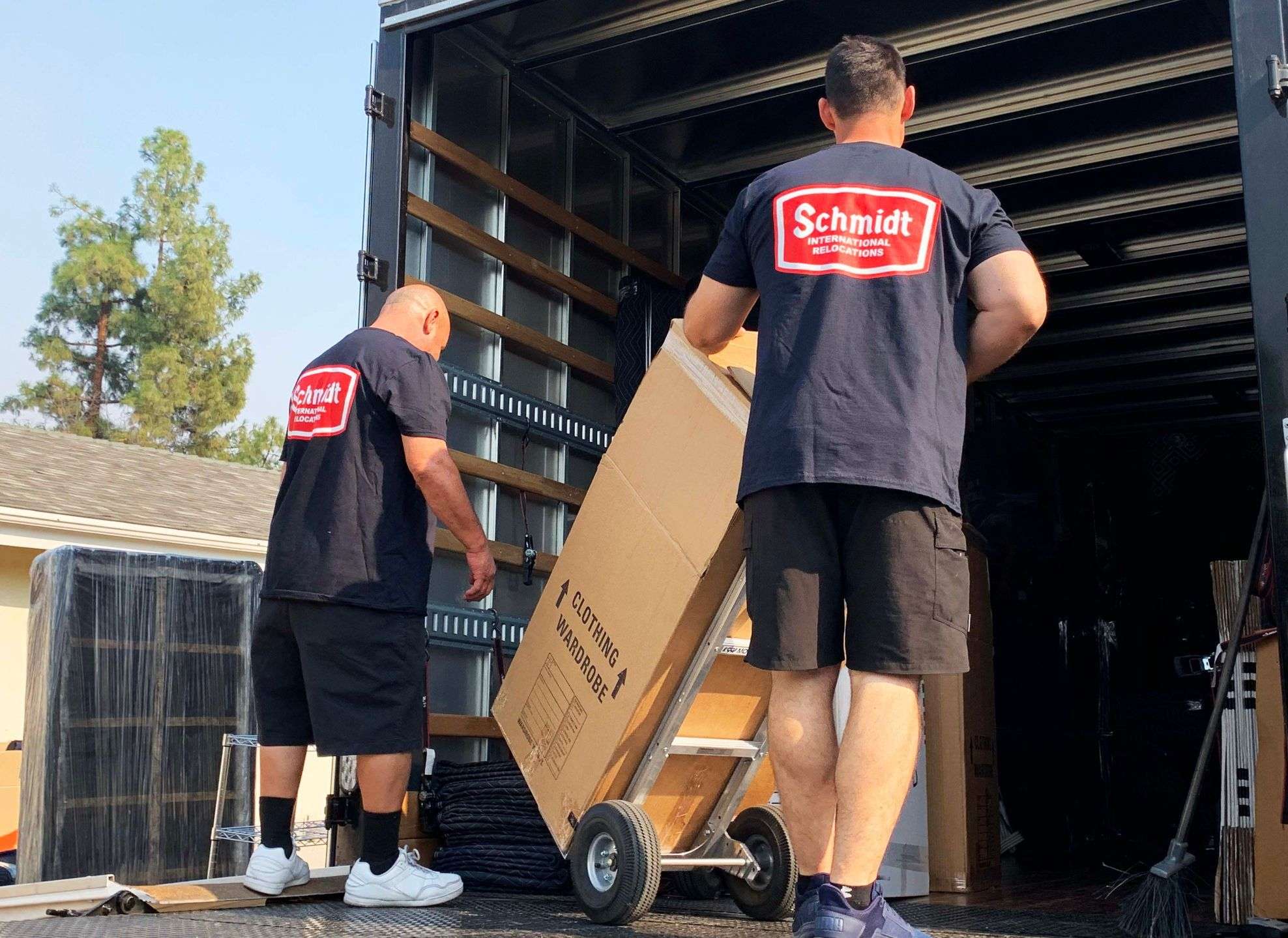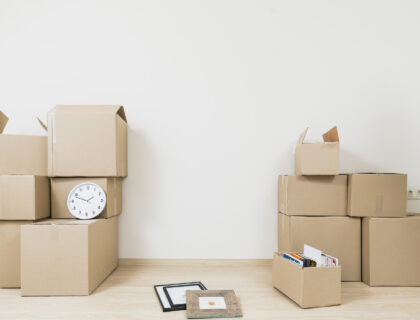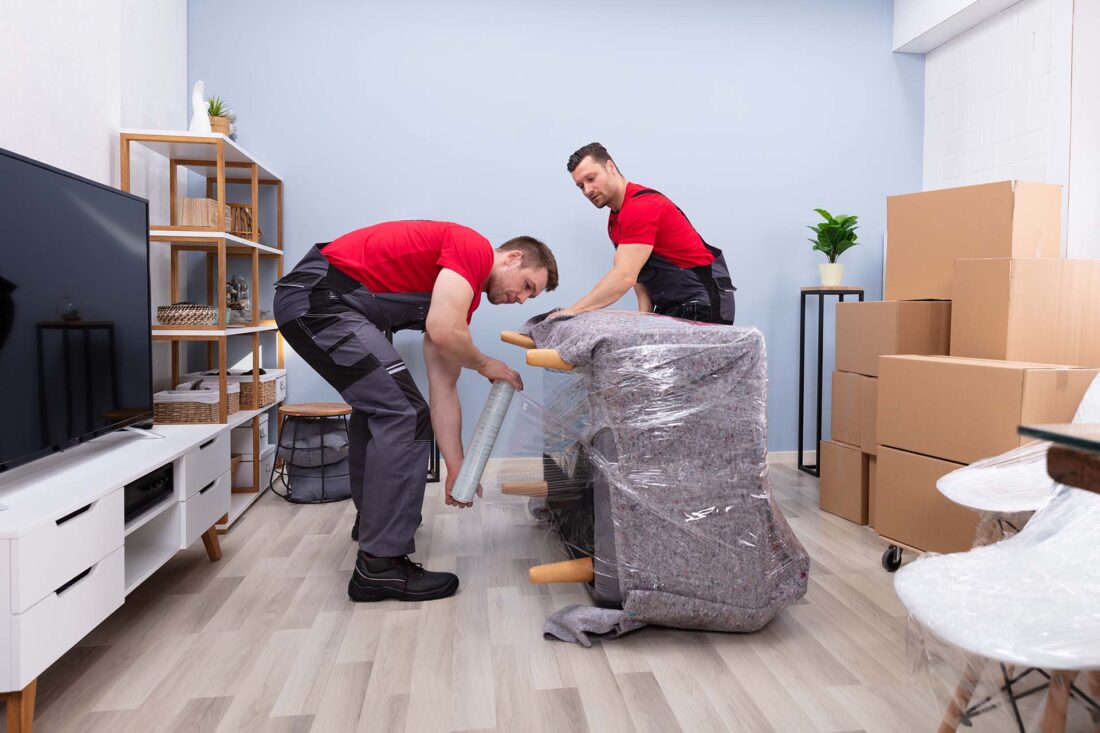

Learning how to pack furniture doesn’t have to pose a challenge. Whether it’s your first big move or you’re a seasoned globe-trotter, we’re here to transform the daunting task of packing furniture into an exhilarating experience. With step-by-step instructions, all cherished furnishings will be safely packed, carrying the joy and anticipation of new beginnings.
How to Pack Furniture – Learn the Basic Instructions
When it comes to moving overseas, knowing how to pack furniture is crucial to ensure you relocate safely and efficiently. We recommend starting with the basics – disassemble large furniture items where possible to make them easier to handle and transport.
Use sturdy, high-quality packing supplies for furniture to protect each piece, focusing on cushioning corners and fragile parts. For packaging large furniture, consider using bubble wrap, furniture blankets, and strong tape to secure everything in place. Label each package clearly, detailing the item inside and its handling instructions.
Keep a detailed inventory to streamline the unpacking process and ensure nothing is misplaced. Following these fundamental steps, you’ll be well-prepared to pack everything securely, making the international relocation smoother and stress-free.
Now, Let’s Break Down the Steps – Begin by Preparing for Packing
Before wrapping up household items for relocating to a new home, it’s crucial to start with a thorough assessment and inventorying. Prepare for the move by examining each item to decide what needs to be transported and what to get rid of, thus defining the relocation essentials.
Consider the dimensions, condition, and utility of each furniture piece in the new space. Creating a detailed inventory list not only helps in keeping track of everything but also aids in determining the amount of materials needed for a secure transition.
Tips for Disassembling Furniture for Easier Packing
Disassembling furniture for moving is a strategic approach to prevent things from breaking during the transition. Begin by consulting any available manuals for guidance on how to dismantle each piece correctly. Use the right tools for unscrewing and separating parts, and keep all hardware, like screws and bolts, in labeled bags for easy reassembly.
Photographing the disassembly process can be a helpful reference when it’s time to reassemble in the new location. This step not only makes items more manageable but also maximizes space in the moving container.
Remember to update the relocation inventory as you disassemble each item, ensuring everything is accounted for before you move to another country. This meticulous approach minimizes the risk of damage and loss, contributing to a more streamlined and secure relocation process.
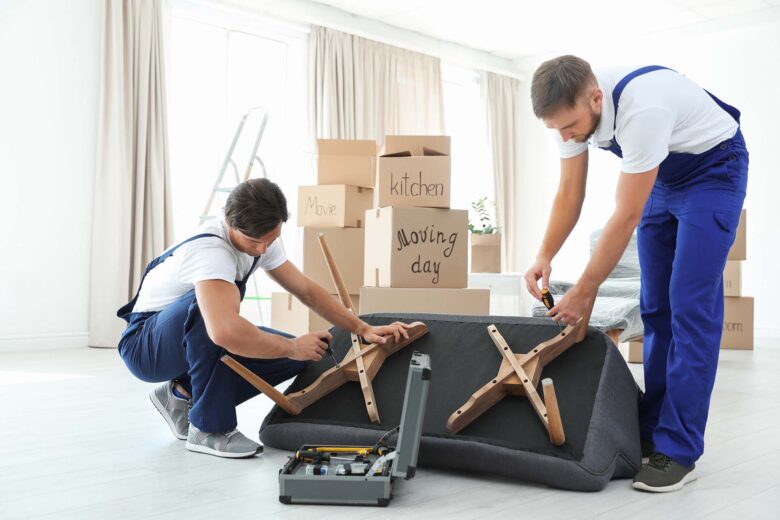
What Packing Materials Should Be Used?
When preparing for moving across the world, selecting the right materials for wrapping household items is paramount. Essential supplies include bubble wrap, furniture blankets, and plastic stretch wrap to keep doors and drawers secured.
These materials can be sourced from various outlets, including home improvement stores or online marketplaces like Craigslist website, where you might find both new and gently used options at reasonable prices.
On top of this, sturdy cardboard boxes of various sizes and tape are indispensable. Investing in quality materials ensures the belongings are well-protected throughout the long journey, making the global relocation worry-free.
How to Choose the Right Materials for Different Types of Furniture?
In crafting a moving abroad checklist, knowing how to match materials to different types of household items is crucial for effective packaging. For fragile items like glassware, bubble wrap and foam padding are ideal for preventing damage.
Furniture blankets are best suited for wooden or metal pieces, offering protection against scratches and impacts. For upholstered items, plastic stretch wrap not only keeps fabric clean but also prevents moisture damage. It’s important to choose boxes that are strong enough to hold the weight of the contents without collapsing.
Specialized materials, like corner protectors or mattress covers, add an extra layer of security for specific items. Matching the right materials to each item ensures they are safely transported abroad.
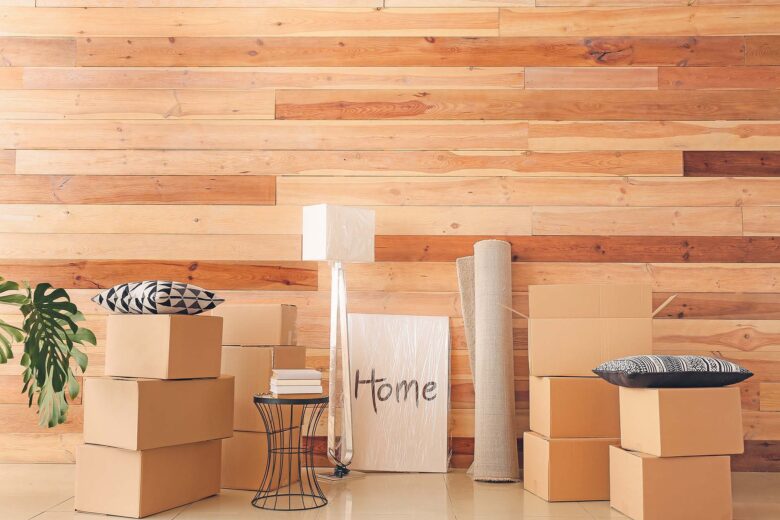
Step-by-Step Packing Methods for Different Types of Furniture
Mastering the step-by-step methods can significantly alleviate the stress of a last-minute relocation rush. For sofas, chairs, and upholstered items, the focus is on protecting fabric and maintaining form. When it comes to wooden pieces like tables and dressers, the emphasis shifts to preventing scratches and structural damage.
When moving fragile furniture, such as glass tables and antiques, the packaging approach centers around ensuring utmost protection against breakage. These methods provide a comprehensive guide to safeguarding the belongings.
How to Pack Sofas, Chairs, and Upholstered Items?
Packaging sofas, chairs, and other upholstered items requires a careful approach, especially when relocating to a smaller home where space optimization is key. Since these belongings are among the most bulky, it’s necessary to have some patience and skill.
Without professional movers, it will be difficult to do it correctly, but if you want to try, these are the steps one needs to know:
- Remove cushions and pack them separately,
- Wrap the entire piece in plastic stretch wrap to protect the fabric from dirt and moisture,
- Cover with furniture blankets for additional protection against bumps and scratches,
- Secure the blankets with packing tape, making sure not to stick tape directly on the upholstery,
- If possible, disassemble any detachable parts like legs or arms for easier transportation.
Techniques for Packaging Wooden Furniture, Like Tables and Dressers?
For those moving out for the first time, packaging wooden furniture can be a daunting task. These pieces can be easily scratched, and any mishandling can be detrimental. So, follow the tips below on how to do this effectively:
- Clean and dry the furniture thoroughly to avoid mold or stains,
- Disassemble removable parts such as legs or shelves,
- Wrap each part in bubble wrap for protection,
- Use furniture blankets to cover the entire piece,
- Secure the blankets with packing tape, ensuring the tape doesn’t touch the wood surface,
- Place smaller components in labeled bags and attach them to the respective furniture.
Tips for Packaging Fragile Furniture Pieces, Such as Glass Tables and Antiques?
Packing fragile furniture pieces requires extra care, particularly for those with anxiety about moving out and the potential risks involved. For valuable items, we recommend investing in packing services and having professional movers pack them properly. However, if you want to do this alone, these are the right instructions:
- Begin by cleaning and drying each item,
- Wrap glass components in paper, followed by bubble wrap,
- Use corner protectors for additional edge protection,
- Surround the entire piece with furniture blankets, securing them with tape,
- If the item is an antique or particularly delicate, consider custom crating for optimal protection,
- Mark the package as ‘Fragile’ and ensure it’s loaded last in the moving truck for accessibility and safety.
Secure Furniture for Transport
Securing items when relocating to a big city involves meticulous wrapping, protection, and strategic loading into the transportation vehicle (a truck or a container). Ensure each piece is securely wrapped with appropriate materials like bubble wrap and furniture blankets, which safeguard against scratches and impacts during transit.
Use sturdy straps to anchor larger items to the sides of the vehicle or container, preventing any movement that could lead to damage. When arranging items, heavier pieces should be placed at the bottom and towards the front of the vehicle or container, creating a stable base. This is complemented by strategically placing lighter and more fragile items on top or in separate, well-padded areas.
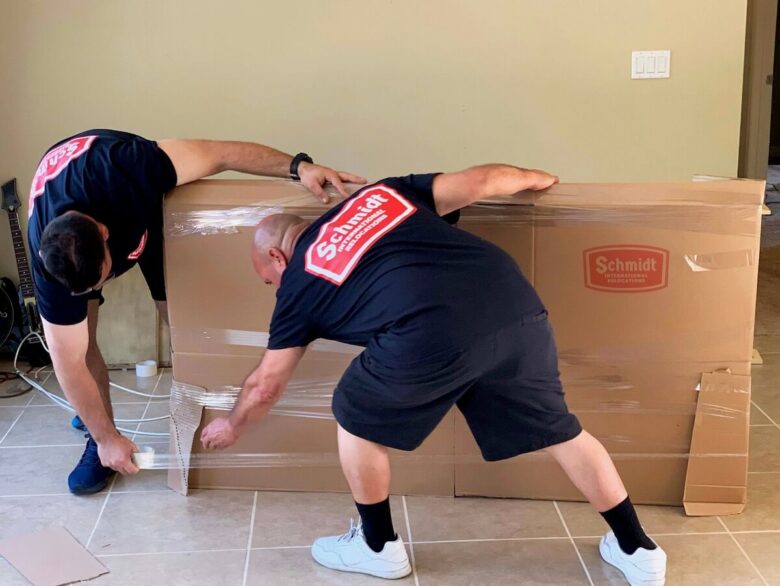
Should You Hire International Movers?
When it comes to the complexities of packaging and wrapping furniture when moving abroad, movers can offer expertise in securing and transporting household possessions across borders. They are equipped with the necessary materials and knowledge to properly wrap and protect furniture, ensuring it withstands the rigors of international transit.
Additionally, these companies are familiar with customs regulations and can navigate the logistical challenges of moving internationally. While the cost may be higher than a DIY furniture packing approach, this can be a worthwhile investment, especially for those unfamiliar with the intricacies of international relocation.
Request Additional Services to Make the Relocation Smooth
It’s worth considering additional services offered by moving companies. These services can include moving by sea or air, which are crucial options depending on your timeline and budget. Moving by sea is typically more cost-effective but takes longer, while air services offer a quicker, albeit more expensive, alternative.
Comprehensive packing services ensure that the belongings are expertly secured. For those with vehicles, car shipping services provide a hassle-free way to transport the car to the new destination. Utilizing these services can streamline the entire relocation process, transforming what could be an overwhelming task into a manageable and smooth transition.
Research Different Companies Before Selecting One
Examine the company’s credentials, including their experience with international moves and customer reviews.
Check their policies on handling delicate items and inquire about their packing techniques for furniture and materials they use. Compare quotes and services from multiple providers to ensure you are getting the best value. Verify if they offer insurance coverage and understand the details of their liability in case of any damage.
Choosing an international moving company with a proven track record in safely moving delicate and valuable items internationally can greatly influence the success of the relocation.
Watch the video below on how to avoid moving scams.

Reach Out to the Best Crew That Can Pack Furniture and Relocate You Across the Globe
In conclusion, for a seamless and stress-free international transition, select the right team to secure and transport all belongings. At Shmidt International Relocations, we specialize in wrapping and transporting household possessions across the globe, ensuring every aspect of the move is handled with precision and care.
Our team of experts is equipped with the skills and experience necessary to cater to all your relocation needs, from securing delicate items to navigating international logistics. We invite you to contact us and experience the peace of mind that comes with entrusting the international move to professionals.
FAQ
How Far in Advance Should I Start Packing My Furniture?
When pondering how to prepare furniture for moving and then pack it, one of the key considerations is timing. Ideally, you should start packing furniture at least six to eight weeks before the move date.
This time frame allows you to carefully assess which items to take, perform any necessary repairs or cleaning, and acquire the right packing materials. Starting early also enables you to methodically disassemble, wrap, and secure each piece, reducing the likelihood of rushed packing, which often leads to damage.
What Are the Best Ways to Protect Delicate Furniture Surfaces?
When considering how to protect furniture when moving, especially delicate surfaces, it’s crucial to select the right packaging supplies and use the right packaging techniques. For surfaces prone to scratches or dents, such as those on antique or high-gloss furniture, soft padding is essential.
Begin by wrapping the surface in soft, clean paper. Follow this with a layer of bubble wrap, providing a cushion against impacts. For added protection, use furniture blankets or pads, which offer a thicker barrier against bumps and scrapes during transit. Secure these layers with packing tape, making sure it doesn’t come in direct contact with the furniture’s surface.
Can I Pack and Move Furniture Without Disassembling It?
For smaller or more compact items, this can be a practical choice. However, for larger items like wardrobes, bed frames, or sectional sofas, disassembly is often recommended to ease transportation and prevent damage. Not disassembling larger pieces can make them more cumbersome to move, increasing the risk of injury to movers or damage to the furniture and property.
How Do I Protect My Furniture While in Storage?
To protect the furniture while in storage, start by cleaning and drying each piece to prevent mold and mildew. Disassemble larger possessions to save space and wrap components in breathable covers or blankets to protect against dust and scratches.
Avoid plastic wrap for long-term storage, as it can trap moisture. Store items off the ground on pallets to guard against flooding or pests. Climate-controlled units are ideal for sensitive materials like wood or leather.
Are There Any Items That Professional Movers Won’t Transport?
Professional movers generally have a list of belongings they won’t transport due to safety, legal, or liability reasons. Hazardous materials like gasoline, propane tanks, paint, and chemicals are typically prohibited. Perishable possessions, including food and plants, will be refused.
Valuable personal items like cash, jewelry, or important documents are often recommended to be transported personally for security reasons. On top of this, some movers might not transport certain large or heavy items like pianos or pool tables without prior arrangement.






